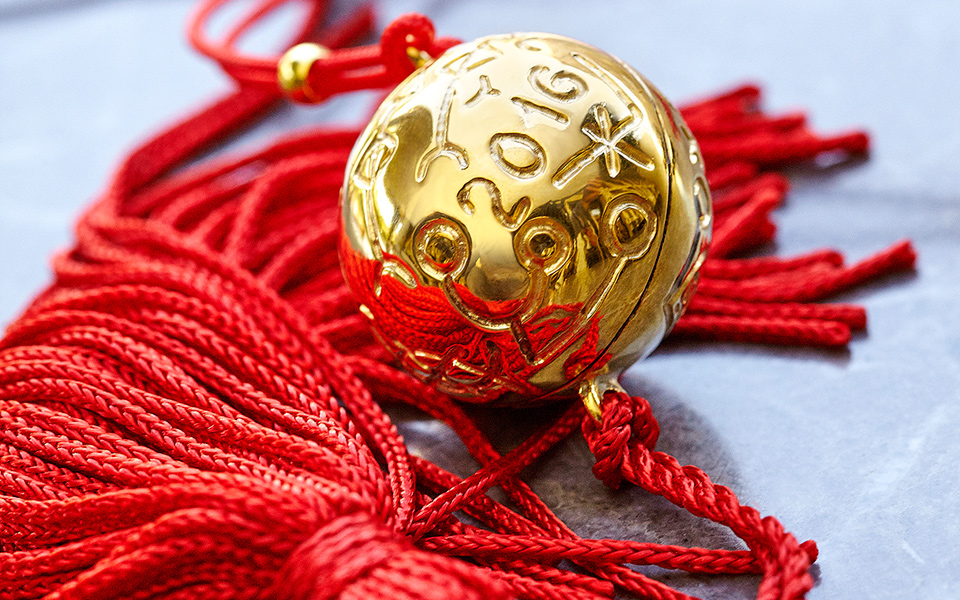A black cat crossing your path won’t necessarily bring you bad luck. You may fall ill even if you do hang a wild onion bulb on your front door. And you may find your dream job without wearing a four-leaf clover. Elvis probably said it best when he sang: “Don’t want a four-leaf clover, don’t want an old horse shoe, want your kiss ‘cause I just can’t miss, with a good luck charm like you.” The fact is though that people since ancient times have sought to attract good luck. Especially as the new year approaches, all over the world there are customs to bring good fortune, from the remotest parts of China to Germany and from Scotland to isolated villages in Greece. It may be just a phrase, a prayer, a candy, a coin, a symbolic object. In Greece, a lucky charm is called gouri.
Looking for more information, we turned to an expert, Aikaterini Polymerou-Kamilaki (PhD, former director, academic associate of the Hellenic Folklore Research Center of the Academy of Athens), who explained the significance and etymology of the Greek lucky charm. “Gouri is anything (an event or object) that brings good luck. The word gouri derives from the Latin augurium (good omen), which in medieval times became agouri(n), influenced also by the Turkish word uǧur (luck) which may have the same origin. In ancient times, omens were birds in flight, usually birds of prey, or other things in nature (the leaves of a tree, the movements of animals and reptiles), the observation of which was the means whereby the ancients foretold the future. In contemporary traditional Greek culture, the signs of fortune are known as gouri (good omen) and prosimado (bad omen). The passage into the new year is associated with customs that are believed to ensure good fortune, which often involve practices and the use of lucky charms. Such practices include the notion of first-foot (podariko), designed to ensure that the first person who enters the house on New Year’s Day is someone considered to be a bringer of good fortune; hanging a strong, wild onion bulb on the door, for the good health of the occupants; wooing the new year by visiting the communal tap, where women in complete silence would offer something before drawing some water, returning to their homes – still without speaking a word – and sprinkling the house and family members with the water. As an object, the purpose of the lucky charm is to bring good fortune or a favorable outcome to some matter of interest or concern. It comes either from the natural world or is fashioned, and nowadays is often also an artistic creation.”
Here, we focus on the latter category and more specifically, the lucky charms of jewelry designers which are sold at the foremost museums in Athens, most of which have been inspired by artifacts on display in their collections. Get your share of good fortune in 2016 by wearing a New Year lucky charm with a theme from ancient or contemporary Greek culture.
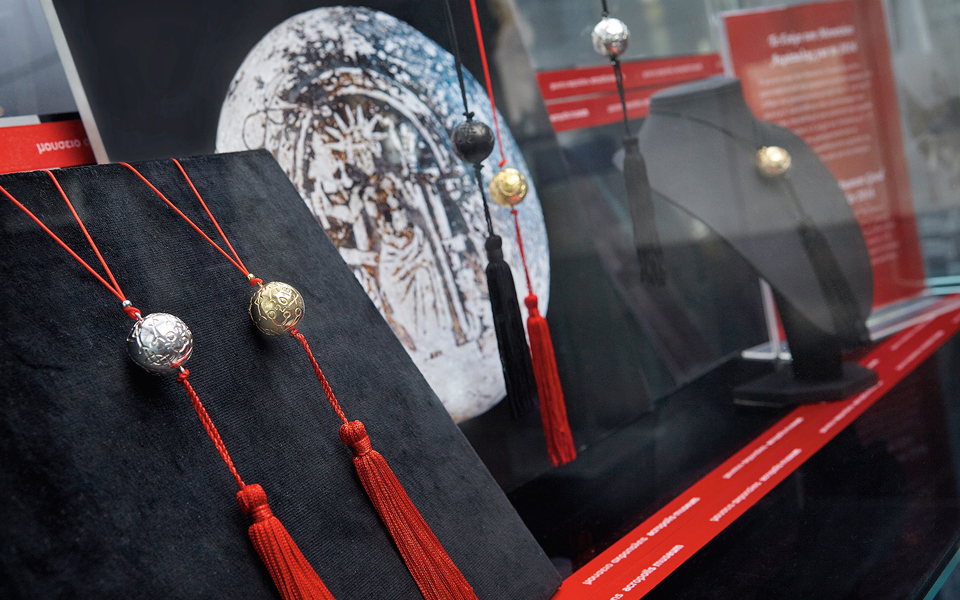
MAGIC SPHERE
The source of inspiration for this lucky charm, depicting the sun god Helios seated on a throne, a lion, a dragon and various magic symbols, is the marble sphere dating to the 2nd-3rd century AD, which is on display on the 1st floor of the permanent exhibition of the Acropolis Museum (Gallery of Antiquities from the 5th century BC to the 5th century AD). In ancient times this sphere, found buried near the Theater of Dionysus, was most probably used in rituals in the hope that its magical power would bring good fortune and pave the way for success.
Meet the artist
“It is clearly much more than a simple object, depicting as it does all these symbols of good, fortune and happiness,” says designer Alexandra Tsoukala, who chose not to make an exact copy of the sphere. “I prefer to take inspiration from an old object because within it, something new is born. The abstract, incomprehensible symbols that adorn the sphere created a sense of magic within me. I began working on it in brass and then, wishing to give it some luster – since it would also be worn as an ornament – it became gilded and silvered. So it took on a new form and use, while retaining inside all its original symbolisms.” When asked if foreigners buy Greek lucky charms, she replies in the affirmative, stressing that “all cultures have their own lucky charms, amulets and talismans. Inside, they contain dreams and hopes for a happier life and this is a global need that goes far beyond ethnicity.
INFO:
Lucky charm “Magic sphere:”
• Material: brass, gold-plated, silver-plated, black, with red or black tassels.
• Dimensions: 1.9 x 2.6 cm.
• Price: €22.80.
• Available: Acropolis Museum, 15 Dionysiou Areopagitou Street, (+30) 210.900.0911.
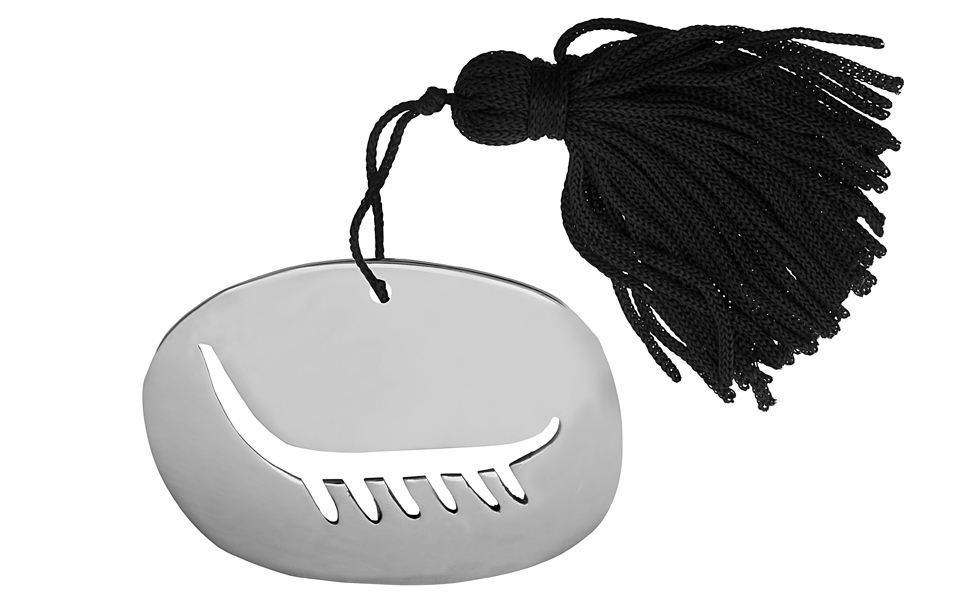
INFO:
Lucky charm “Ships:”
• Material: white silver 925, silver with black platinum plating (necklace, pins, cufflinks), bronze with platinum plating, with gold plating 18K, with black platinum plating (tabletop lucky charm).
• Dimensions: about 5 cm.
• Price: €20-40.
• Available: Museum of Cycladic Art, 4 Neofytou Douka St., (+30) 210.722.8321-3 • Buy online.
SHIPS
The two lucky charm ships on sale at the Museum of Cycladic Art may look similar, but the stories behind their creation are quite different. One (with the curves) was inspired by a rock engraving found at one of the oldest habitation sites in Europe, the Neolithic settlement of Strofilas on Andros, the other (more angular) by an Early Cycladic clay “frying-pan” vessel that is part of the museum’s permanent collection. In addition to the allusion to 2016, the six oars symbolize “perpetual movement, ideas, dreams, hopes, visions, the years that pass and those yet to come.”
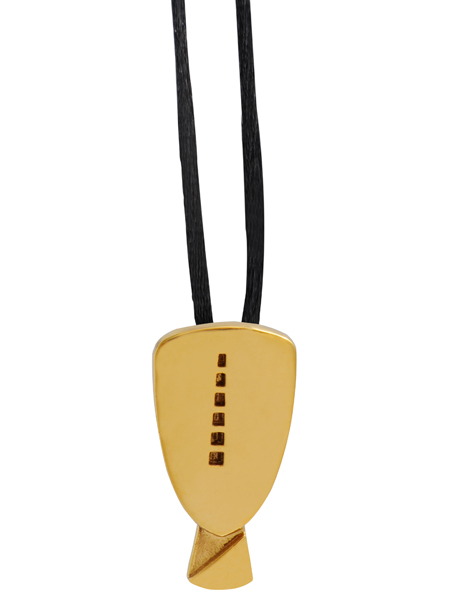
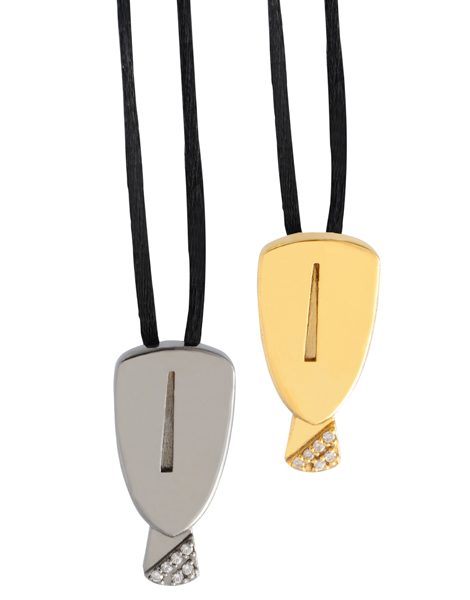
CYCLADIC FIGURINE
The Cycladic figurine needs no introduction. But why did you choose only the head for the design of this lucky charm? “Because the head is the center of the intellect and the senses, the seat of the soul and abode of the emotions. It is a sacred symbol, a totem and a window to the inner and outer world.” And the symbolism of the new year? This is expressed through the six stones (cubic zirconias) around the neck of the figurine. In the Goulandris Collection you can see the original, dating to 2800-2300 BC. Designed as a necklet and as men’s lapel pins.
Meet the artist
Jewelery designer Maria Apostolopoulou, who created the lucky charms, draws inspiration from and is captivated by the symbols of ancient cultures. But she believes that essentially “everyone creates their own luck”. Maria always wears a lucky charm, around her neck or on her hand, which she changes depending on the time of year and her mood. She says that “we charge the lucky charms we wear with energy and if we believe in them, they bring us good fortune.”
INFO:
Lucky charm “Cycladic figurine:”
• Material: silver with black platinum plating, bronze with platinum plating, bronze with gold plating 18K. Plain or with cubic zirconia.
• Dimensions: 2 cm.
• Price: €28-35.
• Available: Museum of Cycladic Art, 4 Neofytou Douka St.,
(+30) 210.722.8321-3
• Buy online.
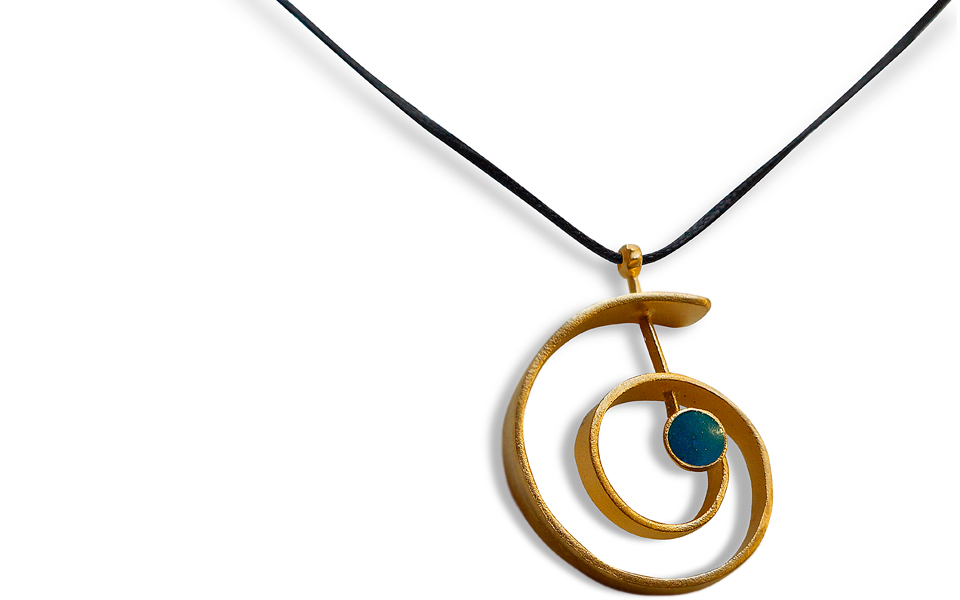
INFO:
Lucky charm “Target:”
• Material: Bronze gold plated necklace with black cord.
• Dimensions: 1.9 x 2.6 cm.
• Price: €22.
• Available: Benaki Museum Shops (Main Building, Pireos St. Annexe & N. Hadjikyriakos-Ghika Gallery).
• Buy online.
TARGET
This symbol of optimism which forms the number 16 was designed by Mina Katsouli. “The spiral is an eternal symbol of positive energy and the target symbolizes our dreams. The spiral forms the number 6 and in the middle there is the figure 1, in resin, which gives emphasis to the heart of our desires, the center of our goals.”
Meet the artist
“Our dreams are our reality”. This is the notion that inspired graphic artist and jewelry designer Mina Katsouli to create the “Target”. This time every year, Mina chooses a lucky charm to wear until the following year. “A lucky charm symbolizes the strength that a person can gain from belief. Since ancient times people communicated with symbols and as a graphic artist, I find them quite enchanting. Something we love has a certain power and ultimately, by believing in the lucky charm you believe in yourself.”
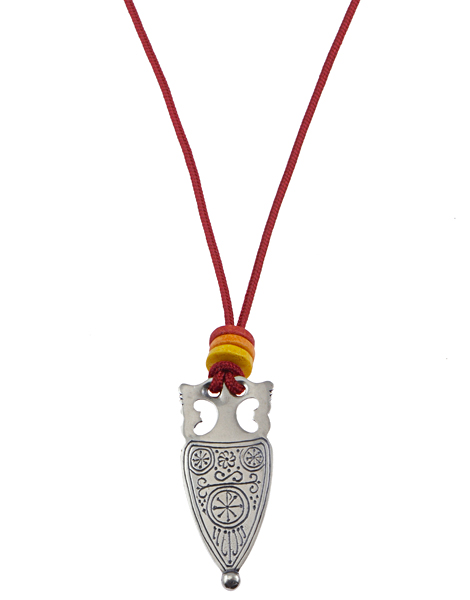
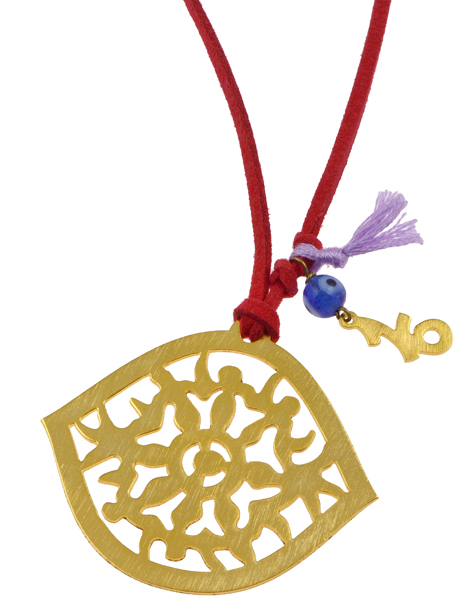
Happiness for 2016
The story behind this lucky charm can be found on the ground floor of the Benaki Museum. For it was inspired by the amphora-shaped detail from a belt, dating to the 4th-5th century BC, the back of which bears the inscription “happiness to the owner of this belt, Diogenis”. The inscription on the back of the charm, written in Greek, wishes “Happiness for 2016”.
Meet the artist
Although jewelry designer Spyros Koukos is not a firm believer in fortune and has no lucky charm, he has developed a special relationship with some of his personal items, especially certain old tools and small objects associated with the history of jewelry making. The lucky charm he created this year was a joint project with his daughter, Katerina Koukou, who believes a little in luck, a little in divine justice and a lot in “the desire to achieve our goal”. Each year for six weeks, just before and after the new year, she wears all the lucky charms she designs with her father.
INFO:
Lucky charm “Happiness for 2016.”
• Material: Silver necklace with red cord.
• Dimensions: 4 x 1.5 cm.
• Price: €25.
• Available: Benaki Museum Shops (Main Building, Pireos St. Annexe & N. Hadjikyriakos-Ghika Gallery).
• Buy online.
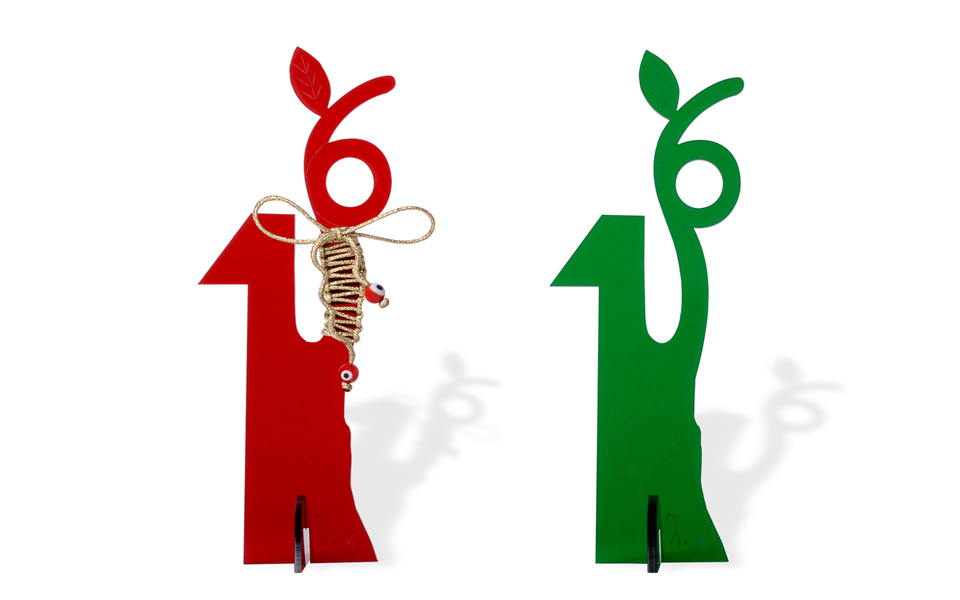
INFO:
Lucky charm “Tree:”
• Material: plexi-glass & silver.
• Dimensions: 15 x 4.8 cm. & 4 x 1.2 cm. respectively.
• Price: €15 & €35 respectively.
• Available: Benaki Museum Shops (Main Building, Pireos St. Annexe & N. Hadjikyriakos-Ghika Gallery).
• Buy online.
TREE
The source of inspiration for this tabletop lucky charm is “the Tree as a timeless, universal symbol of growth, synthesis, unity and singularity. The form of the dry, silver tree from which a single ‘perfect’ leaf grows, is not only a symbol of hope and resistance against the prevailing crisis but also of desire for a better tomorrow.”
Meet the artist
“Foreigners maintain a relatively neutral stance towards lucky charms, choosing that which pleases them aesthetically and not necessarily on the basis of its distinctive attribute,” says designer Lenousa Holeva. In her daily life, she wears lucky charms that she herself has designed. Asked whether people make their own luck, Lenousa replies: “Despite the difficulties and unforeseeable factors that affect our daily life, the way in which we act at each moment, our choices and actions, are what determine the final outcome. So, Luck is in our own hands!”
EMBROIDERY
The idea for this lucky charm comes from the collections of neo-Hellenic secular art at the Benaki Museum. In the shape of an eye, it was inspired by part of a 19th century embroidery from Crete. “Embroidery is a rich source of inspiration and a charming way to connect with our past and history. It is the ‘step’ we leave behind in order to take the next.”
Meet the artist
“Luck is not chance, it’s toil; fortune’s expensive smile is earned,” according to the great American poet Emily Dickinson. And designer Marina Zachou, who created this piece, could not agree more. She believes that on the path of life “the first step is chance but the route is definitely toil. Lucky charms are not part of the mindset of most foreigners, but if they are given one, with the necessary explanations, they generally accept it with great delight, even emotion. I too always accept lucky charms with joy and emotion. For they carry with them wishes, hopes and dreams for the coming year. They are surely much more than an accessory.”
INFO:
Lucky charm “Embroidery:”
• Material: Bronze necklace.
• Dimensions: 6 x 5 cm.
• Price: €30.
• Available: Benaki Museum Shops (Main Building, Pireos St. Annexe & N. Hadjikyriakos-Ghika Gallery).
• Buy online.
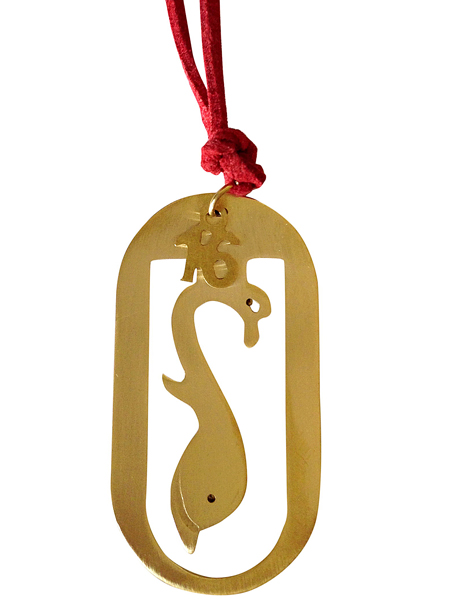
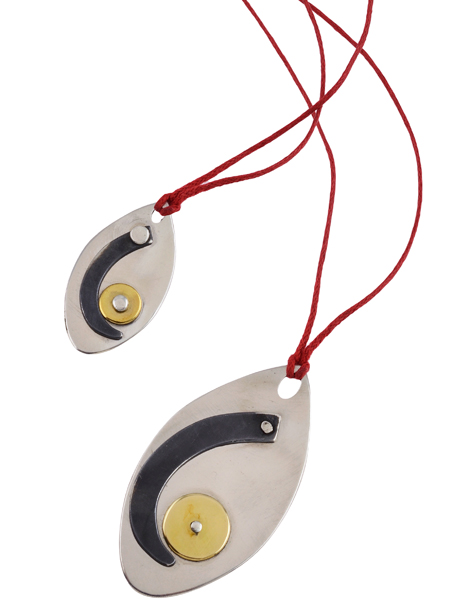
INFO:
Lucky charm “Dolphin:”
• Material: bronze with red ribbon.
• Dimensions: 2.37 x 5 cm.
• Price: €25.
• Available: Benaki Museum Shops (Main Building, Pireos St. Annexe & N. Hadjikyriakos-Ghika Gallery).
• Buy online.
DOLPHIN
This lucky charm page marker is ideal for bibliophiles. From the entire museum, jewelry designer Sophia Tsiliakou chose a small dolphin that adorns a hydria associated with the cult of Aphrodite. The vessel, dating to the second half of the 3rd century BC, is on display in the permanent exhibitions of the Benaki Museum (main building, 1 Koumbari St. & Vas. Sofias Ave.). In ancient Greece, dolphins were seen as helpers of humans and a good omen; for the creator, they are a symbol of joy and hope.
Meet the artist
“I didn’t make an exact copy. I used simple, clean lines to simplify the tiny dolphin but without changing its form,” says Sophia Tsiliakou. Her favorite lucky charm is an eye. “I don’t believe in luck but rather in synchrony. Being in the right place at the right time.”
6
This lucky charm is in the shape of an eye, with the figure 6 in the center. “The symbolism of the charm is the number 6, as I believe numbers have a power of their own, while the eye offers protection, watching out for us and our needs, a type of awareness.”
Meet the artist
For designer Juliette Polac, the lucky charm is “a playful, creative way to make a form that all kinds of people will find appropriate for their own wishes, their own symbolism. Even though I have been doing this work with the Benaki Museum for some years, it is always a surprise for me to see what emerges.” In her home country, France, lucky charms are not so common but, as she points out, in these troubled times the need for symbolic objects is evident everywhere. Juliette herself wears lucky charms and believes that “people are responsible for a part of their luck, but not all.”
INFO:
Lucky charm “6:”
• Material: Silver gold plated necklace with red cord.
• Dimensions: 5.5 x 3 cm. & 3.5 x 2 cm.
• Price: €50 and €30 respectively.
• Available: Benaki Museum Shops (Main Building, Pireos St. Annexe & N. Hadjikyriakos-Ghika Gallery).
• Buy online.
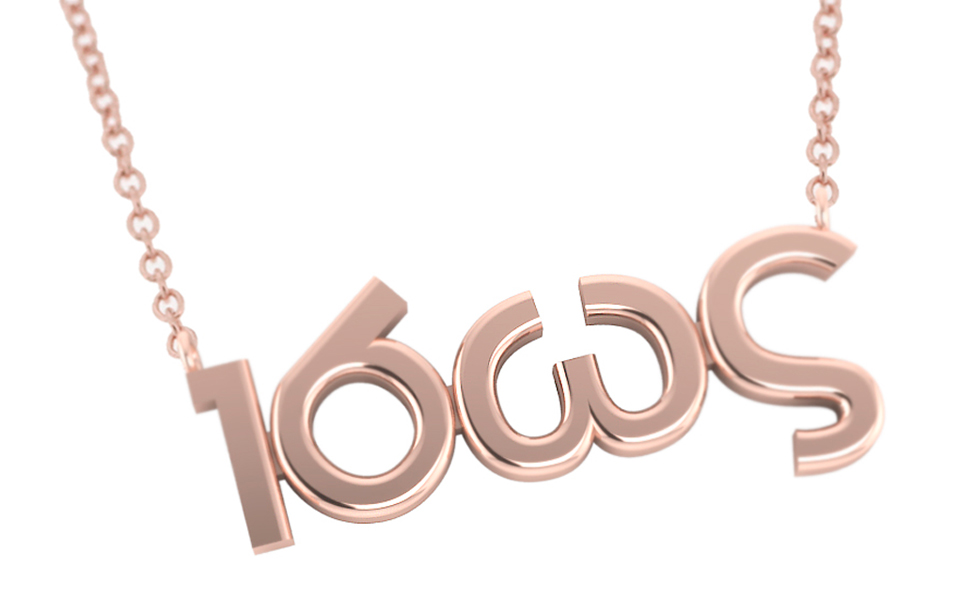
INFO:
Lucky charm “Isos” (maybe:)
• Material: Silver pink gold plated.
• Dimensions: 3 cm.
• Price: €50.
• Available: Benaki Museum Shops (Main Building, Pireos St. Annexe & N. Hadjikyriakos-Ghika Gallery).
• Buy online.
“ISOS” (maybe)
The word “maybe”, which expresses both likelihood and doubt, leaving all possibilities open, written in Greek and with the second letter resembling the figure 6, is the original lucky charm necklace inspired by the crisis.
Meet the artist
“Tomorrow may be magical,” says jewelry designer Nick Garmpis. He has been designing lucky charms for over two decades and every year wears the new pin charm on his lapel. “First, you design it in your soul, then in your mind and finally on paper. I draw inspiration from the crisis and the problems facing the country,” says Nick, who believes that luck is not always the most important factor. “There is also destiny, that which is written for all of us.”
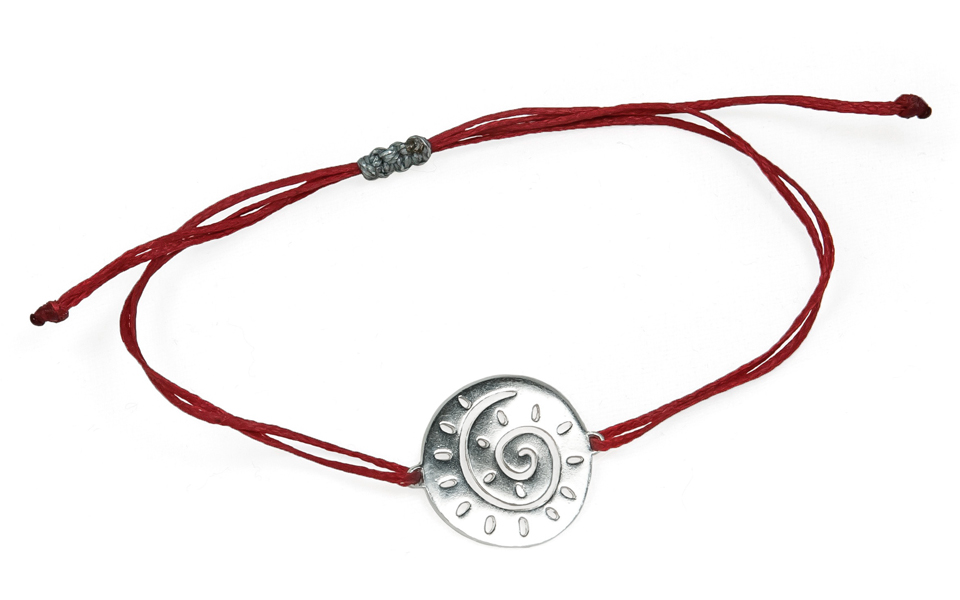
SPIRAL
Inspired by the decoration of an Early Cycladic clay “frying pan” from the island of Evia (Euboea), dating from 2800-2700 BC. “The smooth and endless line imparts a sense of continuity, of development, of life, of evolution. And this is precisely its symbolism.”
Meet the artist
“A lucky charm signifies the relationship we want to have with tomorrow. It is the small, magical object that will bring us our heart’s desire… Something like an amulet,” says jewelry designer Katerina Moraitis. She always wears a lucky charm, usually one given to her by a close friend, because she feels that it fills her with positive energy and strength. Katerina believes that “destiny is a combination of choice and luck.”
INFO:
Lucky charm “Spiral:”
• Material: Silver.
• Dimensions: 3 cm.
• Price: €28.
• Available: Benaki Museum Shops (Main Building, Pireos St. Annexe & N. Hadjikyriakos-Ghika Gallery). • Buy online.

